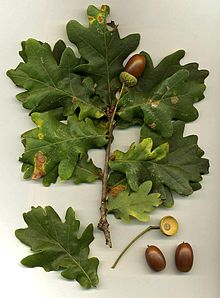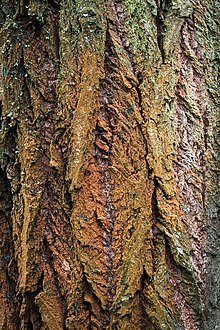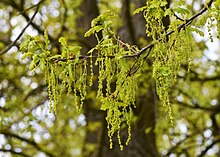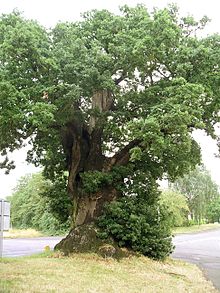Quercus robur
| Quercus robur | |
|---|---|

| |
| Leaves and acorns (note the long acorn stalks) | |
| Scientific classification | |
| Kingdom: | Plantae |
| Clade: | Tracheophytes |
| Clade: | Angiosperms |
| Clade: | Eudicots |
| Clade: | Rosids |
| Order: | Fagales |
| Family: | Fagaceae |
| Genus: | Quercus |
| Subgenus: | Quercussubg.Quercus |
| Section: | Quercussect.Quercus |
| Species: | Q. robur
|
| Binomial name | |
| Quercus robur | |

| |
| Native distribution of pedunculate oak | |
| Synonyms[2] | |
|
List
| |
Quercus robur,thepedunculate oakorEnglish oak,[3][4]is a species offlowering plantin the beech andoakfamily,Fagaceae.It is a large tree,nativeto most ofEuropeand westernAsia,and is widely cultivated in other temperate regions. It grows on soils of near neutralacidityin the lowlands and is notable for its value to natural ecosystems, supporting a very wide diversity of herbivorous insects and other pests, predators and pathogens.
Description[edit]

Quercus roburis adeciduoustree up to 40 m tall,[5]with a single stout trunk that can be as much as 11 m in girth (circumference at breast height) or even 14 m inpollardedspecimens. Older trees tend to be pollarded, with boles (the main trunk) 2–3 m long. These live longer and become more stout than unpollarded trees. The crown is spreading and unevenly domed, and trees often have massive lower branches. The bark is greyish-brown and closely grooved, with vertical plates. There are often large burrs on the trunk, which typically produce many small shoots. Oaks do not producesuckersbut do recover well from pruning or lightning damage. The twigs are hairless and the buds are rounded (ovoid), brownish and pointed.[5][6][7]
Theleavesare arranged alternately along the twigs and are broadly oblong or ovate, 10–12 cm long by 7–8 cm wide, with a short (typically 2–3 mm) petiole. They have a cordate (auricled) base and 3–6 rounded lobes, divided no further than halfway to the midrib. The leaves are usually glabrous or have just a few simple hairs on the lower surface. They are dark green above, paler below, and are often covered in small disks of spangle gall by autumn.[6]

Flowering takes place in spring (early May in England). It is wind-pollinated. The male flowers occur in narrow catkins some 2-4 cm long and arranged in small bunches; the female flowers are small, brown with dark red stigmas, about 2 mm in diameter and are found at the tips of new shoots on peduncles 2-5 cm long.[6]
The fruits (acorns) are borne in clusters of 2-3 on a long peduncle (stalk) 4-8 cm long. Each acorn is 1.5-4 cm long, ovoid with a pointed tip, starting out whitish-green and becoming brown, then black. As with all oaks, the acorns are carried in a shallow cup which can be distinctive in identifying the species.[6]It is an "alternate bearing" species, which means that big crops of acorns are produced every other year.[8]
Taxonomy[edit]
Quercus robur(from theLatinquercus,"oak" +robur"hardwood, oak wood, oak" ) was named byLinnaeusinSpecies Plantarum(vol. 2, p.996) in 1753. It is thetype speciesof the genus and classified in thewhite oaksection (QuercussectionQuercus).[9]
It has numerous common names, including "common oak", "European oak" and "English oak". In French it is called "chêne pédonculé".[10]
The genome ofQ. roburhas been completely sequenced (GenOak project); a first version was published in 2016. It comprises 12 chromosome pairs (2n = 24), about 26,000 genes and 750 millionbp.[11]
There are many synonyms, and numerous varieties and subspecies have been named.[12]The populations in Iberia, Italy, southeast Europe, and Asia Minor and the Caucasus are sometimes treated as separate species,Q. orocantabrica,Q. brutiaTenore,Q. pedunculifloraK. Koch andQ. haasKotschy respectively.[citation needed]
Quercus × rosaceaBechst.(Q. petraeaxQ. robur) is the only naturally-occurring hybrid,[13]but the following crosses with other white oak species have been produced in cultivation:
- Q. × bimundorum(Q. alba×Q. robur) (two worlds oak)
- Q. × macdanielli(Q. macrocarpa×Q. robur) (heritage oak)
- Q. × turneriWilld.(Q. ilex×Q. robur) (Turner's oak)
- Q. × warei(Q. robur fastigiataxQ. bicolor).
There are numerous cultivars available, among which the following are commonly grown:
- 'Fastigiata', cypress oak, is a large imposing tree with a narrow columnar habit.
- 'Concordia', golden oak, is a small, very slow-growing tree, eventually reaching 10 m (33 ft), with bright golden-yellow leaves throughout spring and summer. It was originally raised in Van Geert's nursery atGhentin 1843.
- 'Pendula', weeping oak, is a small to medium-sized tree with pendulous branches, reaching up to 15 m (49 ft).
- 'Purpurea' is another small form, growing to 10 m (33 ft), with purple leaves.
- 'Pectinata' (syn. 'Filicifolia'), cut-leaved oak, is a cultivar where the leaf is pinnately divided into fine, forward-pointing segments.[14]
Identification[edit]
The species most likely to be confused with it issessile oak,which shares much of its range.Quercus roburis distinguished fromQ. petraeaby its leaves having auricles at the base, the very shortpetiole,its clusters of acorns being borne on a long peduncle, and the lack of stellate hairs on the underside of the leaf. The two oftenhybridisein the wild, the hybrid beingQuercus × rosacea.[5]
Turkey oakis also sometimes confused with it, but that species has "whiskers" on the winter buds and deeper lobes on the leaves (often more than halfway to the midrib). The acorn cups are also very different.[8]
Habitat and ecology[edit]

Pedunculate oak is a long-lived tree of high-canopy woodland, coppice and wood-pasture, and it is commonly planted in hedges. When compared to sessile oak, it is more abundant in the lowlands of the south and east in Britain, and it occurs on more neutral (less acid) soils. It is rare on thin, well-drained calcareous (chalk and limestone) soil. Sometimes it is found on the margins of swamps, rivers and ponds, showing that it is fairly tolerant of intermittent flooding.[15]ItsEllenberg valuesin Britain are L = 7, F = 5, R = 5, N = 4, and S = 0.[16]

Within its native range,Q. roburis valued for its importance toinsectsand other wildlife, supporting the highest biodiversity of insect herbivores of any British plant (at least 400 species).[17]The most well-known of these are the ones that form galls, which number about 35. In Britain, theknopper gallis very common, andAndricus grossulariaeproduces somewhat similar spiky galls on the acorn cups. Also common in Britain are two types of spherical galls on the twigs: theoak marble galland thecola nut gall.The latter are smaller and rougher than the former. A single, large exit hole indicates that the wasp inside has escaped, whereas a number of smaller holes shows that it was parasitised by another insect, and these emerged instead. The undersides of oak leaves are often covered inspangle galls,which persist after the leaves fall.[8]
One of the most distinctive galls is theoak apple,a 4.5 cm diameter spongy ball created from the buds by the waspBiorhiza pallida.Thepineapple gall,while less common, is also easily recognised.[18]

The quantity ofcaterpillarspecies on an oak tree increases with the age of the tree,[19]withblue titsandgreat titstiming their egg hatching to the leaves opening.[19]The most common caterpillar species include thewinter moth,thegreen tortrixand themottled umber,all of which can become extremely abundant on the first flush of leaves in May, but the oak trees do recover their foliage later in the year.[8]
The acorns are typically produced in large quantities every other year (unlikeQ. petraea,which produces large crops only every 4-10 years)[8]and form a valuable food resource for several smallmammalsand some birds, notablyEurasian jaysGarrulus glandarius.Jays were overwhelmingly the primary propagators[20]of oaks before humans began planting them commercially (and still remain the principal propagators for wild oaks), because of their habit of taking acorns from the umbra of its parent tree and burying them undamaged elsewhere.[citation needed]
Chemistry[edit]
Grandinin/roburin E,castalagin/vescalagin,gallic acid,monogalloyl glucose (glucogallin) andvaloneic acid dilactone,monogalloyl glucose,digalloyl glucose,trigalloyl glucose,rhamnose,quercitrinandellagic acidare phenolic compounds found inQ. robur.[21]The heartwood containstriterpene saponins.[22]
Diseases[edit]
Notable trees[edit]


It is often claimed that England has more ancient oaks than the rest of Europe combined.[24]This is based on research by Aljos Farjon at theRoyal Botanic Gardens, Kew,who found that there were 115 oaks (of both species) in England with a circumference of 9 m or more, compared with just 96 in Europe. This is attributed to the persistence of mediaeval deer parks in the landscape.[25]The Majesty Oak, with a circumference of 12.2 m (40 ft), is the thickest such tree inGreat Britain.[26]The Brureika (Bridal Oak) inNorwaywith a circumference of 10.86 m (35.6 ft) (in 2018)[27]and theKaive OakinLatviawith a circumference of 10.2 m (33 ft) are among the thickest trees inNorthern Europe.[citation needed]The largest historical oak was known as the Imperial Oak from Bosnia and Herzegovina. This specimen was recorded at 17.5 m in circumference at breast height and estimated at over 150 m³ in total volume. It collapsed in 1998.[28]
Two individuals of notable longevity are theStelmužė OakinLithuaniaand theGranit OakinBulgaria,which are believed to be more than 1500 years old, possibly making them the oldest oaks in Europe; another specimen, called the 'Kongeegen' ('Kings Oak'), estimated to be about 1,200 years old, grows inJaegerspris,Denmark.[29]Yet another can be found inKvilleken,Sweden,that is over 1000 years old and 14 m (46 ft) around.[30]Of maiden (not pollarded) specimens, one of the oldest is the great oak ofIvenack,Germany.Tree-ring researchof this tree and other oaks nearby gives an estimated age of 700 to 800 years. Also theBowthorpe OakinLincolnshire,Englandis estimated to be 1,000 years old, making it the oldest in the UK, although there isKnightwood Oakin theNew Forestthat is also said to be as old. The highest density ofQ. roburwith a circumference of 4 m (13 ft) and more is in Latvia.[31]
In Ireland, atBirr Castle,a specimen over 400 years old has a girth of 6.5 m (21 ft), known as the Carroll Oak.[32]
In theBasque Country(Spain and France), the 'tree of Gernika' is an ancient oak tree located inGernika,under which theLehendakari(Basque prime minister) swears his oath of office.[citation needed]
The largest example in Australia is inDonnybrook,Western Australia.[33]
Commercial forestry[edit]


Quercus roburis planted forforestry,and produces a long-lasting and durableheartwood,much in demand for interior and furniture work. The wood ofQ. roburis identified by a close examination of across-sectionperpendicular to fibres. The wood is characterised by its distinct (often wide) dark and light brown growth rings. The earlywood displays a vast number of large vessels (around0.5 mm or1⁄64inch in diameter). There are rays of thin (about0.1 mm or1⁄256in) yellow or light brown lines running across the growth rings. The timber is around 720 kilograms (1,590 pounds) per cubic meter in density.[34]
In culture[edit]
In theScandinaviancountries, oaks were considered the "thunderstormtrees ", representingThor,the god of thunder.[35]AFinnishmyth is that theWorld tree,a great oak which grew to block the movement of the sky, sunlight and moonlight, had to be felled, releasing its magic, thus creating theMilky Way.[36]The oak tree also had a symbolic value in France. Some oaks were considered sacred by theGauls;druids wouldcut down the mistletoe growing on them.Even afterChristianization,oak trees were considered to protect as lightning would strike them rather than on nearby inhabitation. Such struck trees would often be turned into places of worship, like theChêne chapelle.[citation needed]
In 1746, all oak trees in Finland were legally classified as royal property, and oaks had enjoyed legal protection already from the 17th century.[37]The oak is also the regional tree of theSouthwest Finlandregion.[38]
During theFrench Revolution,oaks were often planted astrees of freedom.One such tree, planted during the1848 Revolution,survived the destruction ofOradour-sur-Glaneby theNazis.After the announcement of GeneralCharles de Gaulle's death, caricaturistJacques Faizantrepresented him as a fallen oak.[citation needed]
In Germany, the oak tree can be found in several paintings ofCaspar David Friedrichand in "Of the life of a Good-For-Nothing" written byJoseph Freiherr von Eichendorffas a symbol of the state protecting every citizen.[citation needed]

In Serbia the oak is a national symbol,[39]having been part of the historicalcoat of armsof theSocialist Republic of Serbia,the historical coat of arms andflagsof thePrincipality of Serbia,as well as the current traditionalcoat of armsandflagofVojvodina.[40]

In England, the oak has assumed the status of a national emblem. This has its origins in the oak tree atBoscobel House,where the futureKing Charles IIhid from hisParliamentarianpursuers in 1650 during theEnglish Civil War;the tree has since been known as theRoyal Oak.This event was celebrated nationally on 29 May asOak Apple Day,which is continued to this day in some communities.[41]
Many place names in England include a reference to this tree, including Oakley, Occold and Eyke. Copdock, inSuffolk,probably derives from a pollarded oak ( "copped oak" ).[42]'The Royal Oak' is the third most popularpub namein Britain (with 541 counted in 2007)[43]andHMSRoyal Oakhas been the name of eight majorRoyal Navywarships. The naval associations are strengthened by the fact that oak was the main construction material for sailing warships. The Royal Navy was often described as "The Wooden Walls of Old England"[44](a paraphrase of theDelphic Oracle) and the Navy's official quick march is "Heart of Oak".In folklore, theMajor Oakis whereRobin Hoodis purportedly to have taken shelter.[45]
Oak leaves (not necessarily of this species) have been depicted on the Croatian 5lipacoin;[46]on old GermanDeutsche Markcurrency (1 through 10 Pfennigs; the 50 Pfennigs coin showed a woman planting an oak seedling), and now on German-issuedeurocurrency coins (1 through 5 cents); and on Britishpound coins(1987 and 1992 issues).
See also[edit]
References[edit]
- ^Barstow, M.; Khela, S. (2017)."Quercus robur".IUCN Red List of Threatened Species.2017:e.T63532A3126467.doi:10.2305/IUCN.UK.2017-3.RLTS.T63532A3126467.en.Retrieved2021-11-19.
- ^"The Plant List: A Working List of All Plant Species".
- ^Trust, Woodland."English Oak (Quercus robur) - British Trees".Woodland Trust.Retrieved2024-06-17.
- ^"USDA Plants Database".plants.sc.egov.usda.gov.Retrieved2024-06-17.
- ^abcStace, C.A. (2019).New Flora of the British Isles(4th ed.). Suffolk: C & M Floristics.ISBN978-1-5272-2630-2.
- ^abcdMitchell, Alan (1974).A Field Guide to the Trees of Britain and Northern Europe.Glasgow: Collins.ISBN0-00-219213-6.
- ^Rose, Francis (2006).The Wild Flower Key.London: Frederick Warne.ISBN978-0-7232-5175-0.
- ^abcdeCrawley, M.J. (2005).The Flora of Berkshire.Harpenden: Brambleby Books.ISBN0-9543347-4-4.
- ^Global Biodiversity Information Facility."Quercus robur L."Retrieved2023-01-29.
- ^Nixon, Kevin C. (1997)."Quercus robur".In Flora of North America Editorial Committee (ed.).Flora of North America North of Mexico (FNA).Vol. 3. New York and Oxford: Oxford University Press – via eFloras.org,Missouri Botanical Garden,St. Louis, MO &Harvard University Herbaria,Cambridge, MA.
- ^Oak genome sequencing
- ^Hassler, M."Synonymic Checklists of the Vascular Plants of the World".
- ^Stace, C.A.; Preston, C.D.; Pearman, D.A. (2015).Hybrid Flora of the British Isles.Bristol: Botanical Society of Britain and Ireland.ISBN978-0-901158-48-2.
- ^Royal Horticultural Society."Quercus robur L."Retrieved2023-02-08.
- ^Preston, C.D.; Pearman, D.A.; Dines, T.D. (2002).New Atlas of the British and Irish Flora.Oxford: Oxford University Press.
- ^Hill, M.O.; Mountford, J.O.; Roy, D.B.; Bunce, R.G.H. (1999).Ellenberg's indicator values for British plants. ECOFACT Volume 2. Technical Annex(PDF).Institute of Terrestrial Ecology.ISBN1870393481.Retrieved2017-05-29.
- ^Kennedy, C. E. J.; Southwood, T. R. E. (1984). "The number of species associated with British Trees: a re-analysis".Journal of Animal Ecology.53(2). Wiley, British Ecological Society: 459.doi:10.2307/4528.JSTOR4528.
- ^Redfern, Margaret; Shirley, Peter (2002). "British Plant Galls".Field Studies.10:207–531.
- ^abMacDonald, Benedict (2019).Rebirding(2020 ed.). Exeter: Pelagic. p. 78.ISBN978-1-78427-219-7.
- ^White, John (1995).Forest and Woodland Trees in Britain.Oxford University Press. p. 131.ISBN0-19-854883-4.
- ^Analysis of oak tannins by liquid chromatography-electrospray ionisation mass spectrometry. Pirjo Mämmelä, Heikki Savolainenb, Lasse Lindroosa, Juhani Kangasd and Terttu Vartiainen, Journal of Chromatography A, Volume 891, Issue 1, 1 September 2000, Pages 75–83,doi:10.1016/S0021-9673(00)00624-5
- ^Identification of triterpene saponins in Quercus robur L. and Q. petraea Liebl. Heartwood by LC-ESI/MS and NMR. Arramon G, Saucier C, Colombani D and Glories Y, Phytochem Anal., November-December 2002, volume 13, issue 6, pages 305–310,PMID12494747
- ^"Oak mildew".Forestry Commission.2013.Retrieved2013-04-13.
- ^"The Ancient Oaks of England".BRAHMS online.Oxford University.Retrieved2023-05-20.
- ^Farjon, Aljos (2022).Ancient Oaks in the English Landscape.Kew: Royal Botanic Gardens.ISBN978-1842467664.
- ^"Britain's record-breaking trees",The Daily Telegraph
- ^"The thickest, tallest, and oldest trees in Norway".
- ^"Pedunculate Oaks (Quercus robur) worldwide".
- ^"Kong Frederik den Syvendes Stiftelse paa Jægerspris".www.kongfrederik.dk.Retrieved2017-10-23.
- ^Moström, Jerker (May 2006)."The Oak Tree, from Peasant Torment to a Unifying Concept of Landscape Management"(PDF).The Oak – History, Ecology Management and Planning.Linköping, Sweden: National Heritage Board of Sweden. Archived fromthe original(PDF)on 2015-01-23.
- ^Eniņš, Guntis (2008).100 dižākie un svētākie,AS Lauku Avīze, p. 25.ISBN978-9984-827-15-5
- ^Fifty Trees of Distinction by Prof. D.A. Webb and the Earl of Ross. Booklet, published by Birr Castle Demesne, 2000.
- ^Nina Smith (10 December 2009)."Australia's Biggest Oak Tree".Donnybrookmail.com.au. Archived fromthe originalon 2011-07-06.Retrieved2012-05-02.
- ^British Oak.Niche Timbers. Accessed 19-08-2009.
- ^Marja-Leena Huovinen; Kaarina Kanerva (1982).Suomen terveyskasvit: luonnon parantavat yrtit ja niiden salaisuudet(in Finnish). Helsinki: Valitut Palat. p. 256.ISBN951-9078-87-8.
- ^Nykänen, Topi (6 August 2006)."Elämänvoiman juurella".Turun Sanomat(in Finnish).Archivedfrom the original on 2022-06-03.Retrieved2022-06-03.
- ^"Pipolan tammimetsikkö".aikamatkakarjalohjalla.fi(in Finnish). Karjalohjan Kotiseutuyhdistys. 2019.Archivedfrom the original on 2022-06-03.Retrieved2022-06-03.
- ^"Tammi".Luontoportti(in Finnish).Archivedfrom the original on 2022-06-03.Retrieved2022-06-03.
- ^Elisabeth Hackspiel-Mikosch; Stefan Haas (2006).Civilian uniforms as symbolic communication: sartorial representation, imagination, and consumption in Europe (18th - 21st century).Franz Steiner Verlag. p. 196.ISBN978-3-515-08858-9.
The oak, symbol of Serbia, symbolized strength, longevity, and the olive branch represented peace and fertility
- ^"Покрајинска скупштинска одлука о изгледу и коришћењу симбола и традиционалних симбола Аутономне покрајине Војводине".Službeni liist AP Vojvodine(in Serbian) (51). 15 September 2016.
- ^"Wiltshire - Moonraking - Oak Apple Day".BBC. 29 May 1931.Retrieved2012-05-02.
- ^Sanford, Martin; Fisk, Richard (2010).A Flora of Suffolk.Ipswich: D.K. & M.N. Sanford.ISBN978-0-9564584-0-7.
- ^"Real Ale and Pub News Features Archive".Solihullcamra.org.uk. 15 November 2007. Archived fromthe originalon 2012-03-01.Retrieved2012-05-02.
- ^"National Maritime Museum".Nmm.ac.uk.Retrieved2012-05-02.
- ^"The Definitive List of British Oak Trees & Their History | EHBP".English Heritage Buildings.16 February 2018.Retrieved2018-03-12.
- ^Croatian National BankArchived6 May 2009 at theWayback Machine.Kuna and Lipa, Coins of CroatiaArchived22 June 2009 at theWayback Machine:5 Lipa CoinArchived4 June 2011 at theWayback Machine.– Retrieved on 31 March 2009.
- Flora Europaea:Quercus robur
- Bean, W. J. (1976).Trees and shrubs hardy in the British Isles8th ed., revised. John Murray.
- Rushforth, K. (1999).Trees of Britain and Europe.HarperCollinsISBN0-00-220013-9.
- (in French)Chênes:Quercus robur
External links[edit]
- Oaks from Bialowieza Forest in Poland (biggest oak cluster with the monumental sizes in Europe) {English}
- Monumental Trees, Photos and location details of large English oak trees
- Latvia - the land of oaks
- Quercus robur- information, genetic conservation units and related resources.European Forest Genetic Resources Programme(EUFORGEN)

